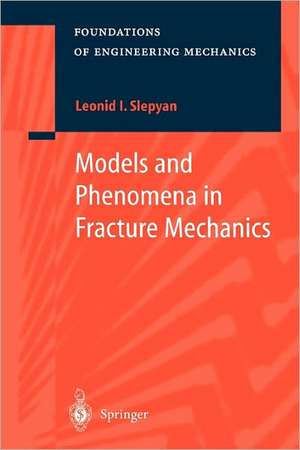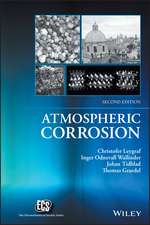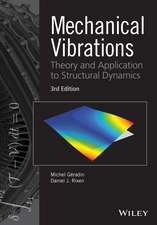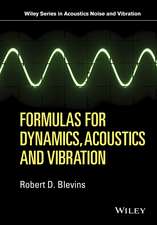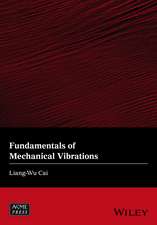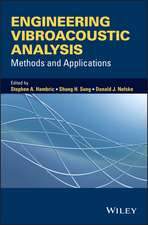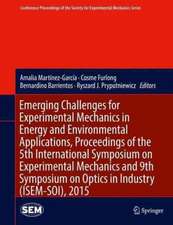Models and Phenomena in Fracture Mechanics: Foundations of Engineering Mechanics
Autor Leonid I. Slepyanen Limba Engleză Paperback – 8 dec 2010
| Toate formatele și edițiile | Preț | Express |
|---|---|---|
| Paperback (1) | 1231.16 lei 6-8 săpt. | |
| Springer Berlin, Heidelberg – 8 dec 2010 | 1231.16 lei 6-8 săpt. | |
| Hardback (1) | 1237.61 lei 6-8 săpt. | |
| Springer Berlin, Heidelberg – 21 aug 2002 | 1237.61 lei 6-8 săpt. |
Din seria Foundations of Engineering Mechanics
- 15%
 Preț: 585.26 lei
Preț: 585.26 lei - 18%
 Preț: 1112.30 lei
Preț: 1112.30 lei - 18%
 Preț: 786.36 lei
Preț: 786.36 lei - 15%
 Preț: 650.55 lei
Preț: 650.55 lei - 15%
 Preț: 646.11 lei
Preț: 646.11 lei - 18%
 Preț: 948.47 lei
Preț: 948.47 lei - 18%
 Preț: 956.69 lei
Preț: 956.69 lei - 15%
 Preț: 643.34 lei
Preț: 643.34 lei - 18%
 Preț: 948.47 lei
Preț: 948.47 lei - 18%
 Preț: 953.82 lei
Preț: 953.82 lei - 18%
 Preț: 951.29 lei
Preț: 951.29 lei - 18%
 Preț: 1386.62 lei
Preț: 1386.62 lei - 15%
 Preț: 644.49 lei
Preț: 644.49 lei - 18%
 Preț: 2117.76 lei
Preț: 2117.76 lei - 18%
 Preț: 951.91 lei
Preț: 951.91 lei - 18%
 Preț: 957.62 lei
Preț: 957.62 lei -
 Preț: 391.99 lei
Preț: 391.99 lei - 18%
 Preț: 1223.43 lei
Preț: 1223.43 lei - 18%
 Preț: 1213.46 lei
Preț: 1213.46 lei - 15%
 Preț: 634.32 lei
Preț: 634.32 lei - 15%
 Preț: 644.30 lei
Preț: 644.30 lei - 18%
 Preț: 952.26 lei
Preț: 952.26 lei - 15%
 Preț: 646.11 lei
Preț: 646.11 lei - 15%
 Preț: 641.71 lei
Preț: 641.71 lei - 15%
 Preț: 635.01 lei
Preț: 635.01 lei - 18%
 Preț: 955.25 lei
Preț: 955.25 lei - 18%
 Preț: 1234.46 lei
Preț: 1234.46 lei - 20%
 Preț: 1289.59 lei
Preț: 1289.59 lei - 18%
 Preț: 952.89 lei
Preț: 952.89 lei - 18%
 Preț: 1247.88 lei
Preț: 1247.88 lei - 18%
 Preț: 947.18 lei
Preț: 947.18 lei - 15%
 Preț: 631.21 lei
Preț: 631.21 lei
Preț: 1231.16 lei
Preț vechi: 1501.41 lei
-18% Nou
Puncte Express: 1847
Preț estimativ în valută:
235.58€ • 246.63$ • 194.93£
235.58€ • 246.63$ • 194.93£
Carte tipărită la comandă
Livrare economică 05-19 aprilie
Preluare comenzi: 021 569.72.76
Specificații
ISBN-13: 9783642078453
ISBN-10: 3642078451
Pagini: 600
Ilustrații: XVII, 576 p.
Dimensiuni: 155 x 235 x 32 mm
Greutate: 0.83 kg
Ediția:Softcover reprint of hardcover 1st ed. 2002
Editura: Springer Berlin, Heidelberg
Colecția Springer
Seria Foundations of Engineering Mechanics
Locul publicării:Berlin, Heidelberg, Germany
ISBN-10: 3642078451
Pagini: 600
Ilustrații: XVII, 576 p.
Dimensiuni: 155 x 235 x 32 mm
Greutate: 0.83 kg
Ediția:Softcover reprint of hardcover 1st ed. 2002
Editura: Springer Berlin, Heidelberg
Colecția Springer
Seria Foundations of Engineering Mechanics
Locul publicării:Berlin, Heidelberg, Germany
Public țintă
ResearchCuprins
1 Fundamentals and Basic Relations.- 1.1 Energy Release and Energy Criterion.- 1.2 Some Methods for Determination of Energy Release.- 1.3 Other Examples of the Energy Release Phenomenon.- 1.4 Stress Intensity Criterion.- 1.5 Some Fracture-Associated Phenomena.- 2 Fourier Transform and Related Topics.- 2.1 Continuous Fourier Transform.- 2.2 Wiener-Hopf Technique.- 2.3 Laplace and Fourier Transform.- 2.4 Discrete Fourier Transform.- 3 Waves.- 3.1 Waves of Sinusoidal and Exponential Types.- 3.2 Waves in Periodic Structures.- 3.3 Forced Waves.- 3.4 Waves in Homogeneous Space and Half-Space.- 3.5 Nonlinear Waves in a String.- 4 One-dimensional Models.- 4.1 String Model.- 4.2 Bending Beam Model.- 5 Static Cracks in a Linearly Elastic Body.- 5.1 Field Representations.- 5.2 Kolosov—Muskhelishvili Representation.- 5.3 Papkovich Representation.- 5.4 Crack in an Unbounded Plane.- 5.5 Asymptotes.- 5.6 Homogeneous Solutions.- 5.7 Integral Equations for a General Crack System.- 5.8 Crack Interaction.- 5.9 Energy Release Under Crack Kink.- 5.10 Cohesive Zone Model.- 5.11 Penny-Shaped Crack.- 5.12 Betti#x2019;s Theorem and the Weight Functions.- 6 Nonlinear Elastic Body.- 6.1 Some Data from Nonlinear Elasticity.- 6.2 Lagrangian and Eulerian Interpretation of Linear Elasticity.- 6.3 Strains in the Neighborhood of a Singular Point.- 6.4 Exact Relationships for the Energy Release and Some Consequences.- 7 Viscoelastic Fracture.- 7.1 Some Data from Viscoelasticity.- 7.2 Stationary Crack and Collinear Crack System.- 7.3 Growing Crack.- 7.4 Cohesive Zone for Viscoelastic Material.- 8 Elastic-Plastic Fracture.- 8.1 Elastic-Plastic Fields.- 8.2 Fixed Cracks.- 8.3 Growing Cracks.- 8.4 Elastic-Plastic Dynamic Fracture.- 9 Dynamic Fracture in a Homogeneous Elastic Medium.- 9.1 Some BasicRelations.- 9.2 Crack Tip Asymptotes and the Energy Release.- 9.3 Factorization of the Fundamental Solutions.- 9.4 Uniform Crack Propagation.- 9.5 Nonuniform Crack Speed Problem.- 9.6 Self-Similar Dynamic Problems.- 9.7 Dynamic Crack in a Plate Under Bending.- 9.8 Principle of Maximum Energy Dissipation Rate.- 10 Cracks in a Bending Plate.- 10.1 Asymptotic Solution for a Single Crack.- 10.2 Radial Cracking with Closure.- 10.3 Self-Similar Dynamic Problem.- 11 The Square-Cell Lattice.- 11.1 Preliminaries.- 11.2 Some Introductory Remarks.- 11.3 Elastic Lattice: Formulation and the Governing Equation.- 11.4 Factorization.- 11.5 Solutions.- 11.6 Viscoelastic Lattice.- 12 Triangular-Cell Elastic Lattice.- 12.1 Introductory Remarks.- 12.2 General Properties of Fundamental Solutions.- 12.3 Equations and General Solutions.- 12.4 Macrolevel-Associated Solution.- 12.5 Microlevel Solutions.- 12.6 Concluding Remarks.- 13 Phase Transition Waves.- 13.1 Introductory Remarks.- 13.2 Macrolevel Solution.- 13.3 Discrete Chain.- 13.4 Higher-Order-Derivative Model.- 13.5 Concluding Remarks.- 14 Dynamic Amplification Factor in Fracture and Phase Transition.- 14.1 Introductory Remarks.- 14.2 Line of Viscoelastic Oscillators.- 14.3 DOR and SAR Domains for Viscoelastic Oscillator.- 14.4 Viscoelastic Square-Cell Lattice.- 14.5 Slow Phase Transition Wave in a Chain.- 14.6 Triangular-Cell Lattice Irregularities in Fracture.- References.
Textul de pe ultima copertă
Modern concepts of fracture mechanics are presented consecutively. Homogeneous and structured models, where microstructure plays an essential role, are considered for fracture and phase transition. Firstly, one-dimensional models are comprehensively studied allowing one to retrace the main phenomena without technical difficulties. More realistic models are then used as linear and nonlinear elastic mediums, such as elastic plates with crack closure, viscoelastic discrete lattices, chains and cohesive zone models. Also considered are, crack origination, equilibrium, slow and fast growth. Sub- and super critical crack speed regimes and transition from one regime to another are studied. Fourier transform and related topics, including a version of the Wiener-Hopf technique dealing with originals are presented, as well as required topics from wave theory. This book is targeted at researchers of materials and structures, also at lecturers and advanced students.
Caracteristici
Describes and compares advanced models in fracture mechanics Presents the most improtant results, methods and open questions Introduces required mathematical technique, mainly the theory of analytical functions
